Watch the Arm Movement of the NHL players in the 2020 Fastest Skater Competition.
If the skating leg is pushing directly sideways on the ice, the arms should also move sideways. It has been suggested that the arms should move forward and backward in such a way that the elbows stay close to the ribs as they move (Glantz, 2010 #96;Stamm, 2010 #81). (Stamm, 2010 #81) suggested that the skater finish each forward and backward swing of the arms with the elbows straight and with the palms of the hands facing upwards. As stated by a hockey coach (Glantz, 2010 #96), “The importance of correct arm swing when skating cannot be minimized either. Make every attempt to have your arms swing to the front, with one hand on the stick, in the direction you are going, not passing the mid-section of your body because that can take your momentum from side to side and throw off your balance, all resulting in a loss of speed.”
Another hockey coach (Rhoads, 2010 #82) has suggested, “Keep your arms tight to your side. One of the biggest mistakes that a lot of people make skating is that they let their arms move loosely, often from side to side. Any motion that isn’t in the direction that you’re skating is just bleeding off energy and causing your balance to lower. Keep your arms tight at your side, and pump them in the direction of your motion, not from side to side.”
A further suggestion follows (Roy, 2010 #95), “We teach players off and on the ice to exaggerate the arm swing. I want the arms thrown directly forward and and back, with an elbow bend on the way back and a full extension of the arm on the way forward. The elbows should be kept in. If the elbows go out to the side then the arms invariably start to move side to side again. The arms when thrown forward should come from underneath and up, like a typical arm swing, i.e. not straight out from the shoulder. The arm thrust forward should not come up above the chin.” The previous authors are in error in their description of the direction of motion in skating being directly down the ice.
(Bracko, 1996 #74) studied the effect of different shoulder movements on acceleration in high school hockey players. Each subject was randomly instructed to accelerate with one of two shoulder movements, either abduction/adduction or flexion/extension. No significant differences were found between acceleration techniques, but the researchers did find differences between groups that approached statistical significance. The athletes who performed shoulder adduction/abduction were faster than those who performed flexion extension {Bracko, 1996 #74}. It was further reported that 13 subjects were eliminated from the data analysis due to an inability to perform the flexion/extension actions of the arms in hockey skating. They suggested that this finding may be an indication that natural movements of the shoulders during acceleration are abduction and adduction, or “side to side” shoulder movements
Hockey coaches should teach the arm swing in a sideways direction rather than in the forward backward direction, in order to produce more skilled and faster skaters. The arm swing sideways produces higher ground reaction forces on the driving skate so the push off will produce higher ground reaction forces. Coaches will also find that this sideways motion is a more natural movement for most skaters, this arm swing will be easier to learn and that it will improve the power and smoothness of the skating stride.

Hockey Institute – All Rights Reserved – Calgary Web Design by Blue Ocean